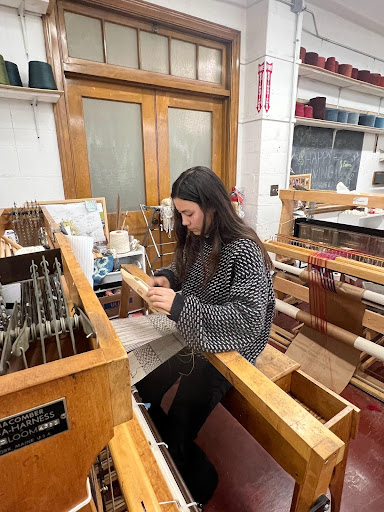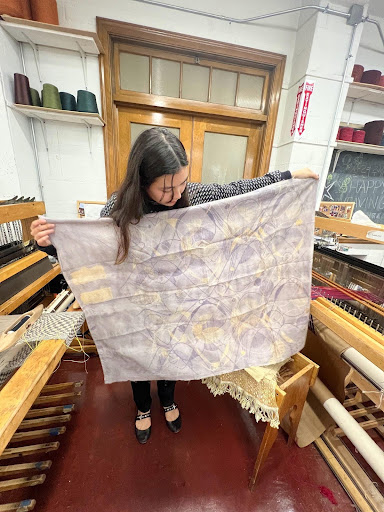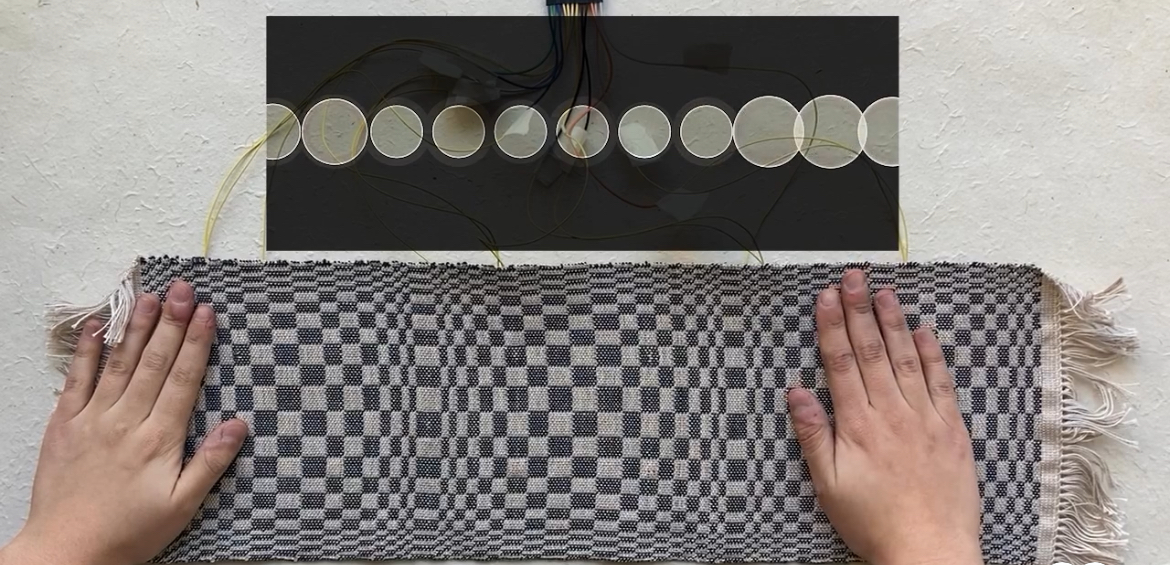Abbey Foreman
Deanne Fernandes
→MFA ILL 2024
Abbey Foreman
→ BFA TX 2025

Abbey at her loom demonstrating the weaving process
As I enter the magical room hidden away in College Building, I am greeted by the magnificent spectacle of more than thirty meticulously arranged looms. The walls are bedecked with threads and dyed fabrics, forming a tapestry in their own unique way. Abbey gracefully navigates the intricate array of looms around the room before settling into her seat. The tactile allure of textiles' physicality is what captivates her, she says—the delicate dance of fibers intertwining within each meticulous stitch. The process of producing textiles, from the thread to the finished piece, is significant. It’s not merely about the act of weaving threads together but about the stories and memories interwoven within each fabric. Natural dyes, sourced from the earth, add a layer of narrative into the textiles. In embracing the physicality of textiles, Abbey finds herself immersed in a world where craftsmanship meets storytelling and the tangible becomes a vessel for intangible memories to live on.

Geometric shapes play an integral role in Abbey's textile creations
While acknowledging her profound appreciation for the tactile, Abbey reflects on her place in a generation shaped by the digital age, having been born into a world where the internet is part of the fabric of everyday life. At RISD, her practice is centered around combining the physical with the digital world by utilizing digital methods to create her material. I couldn’t quite fathom the way in which a handwoven rug could be digitized until Abbey explained to me that stitches in a textile mirror pixels in a digital realm. Despite the apparent complexity of woven patterns, there are simple rules that converge to form the whole, a process that can be replicated through coding in the digital space.
Abbey's transition into weaving within the online domain mirrored the uncertainty she felt when she first delved into the physical realm of textiles. Weaving relies on two primary elements: the warp, composed of vertical threads, and the weft, which is woven horizontally through the warp. Weavers follow specific sequences to interlace warp and weft threads to create various weave structures, such as plain weave, twill, or satin. These systems have distinct rules for thread placement in order to achieve certain results. In both cases, Abbey experienced apprehension, stemming from a fear of making mistakes and having to start over. A misplaced stitch or an error in coding could disrupt the entire process; precision and attention to detail are essential in both methods. She overcame her fear of making mistakes by realizing that she could always go back to square one.
Abbey is currently delving into the realm of coding for her textile projects, recognizing its potential to unlock a world of creative possibilities, like converting the tactile touch of the fabric itself into digitized emotions and words on a screen. Through coding, she envisions the ability to embark on large-scale endeavors such as projection mapping and sensory experiences, offering avenues for innovative expression and immersive storytelling. By integrating digital methods into her textile practice, Abbey anticipates pushing the boundaries of traditional craftsmanship, infusing her work with dynamic interactivity. Her audience can now be a part of her piece and co-create the narrative. Abbey has launched a website titled https://text-iles.glitch.me/, which realizes the idea that “Textiles are best appreciated slowly.” This interactive platform, crafted by Abbey, features a unique double weave pattern design that you can flip to view the reverse, mirrored, side. As you gradually scroll your mouse over the piece, a conversation slowly unfolds, revealing itself “stitch” by “stitch.” Through this innovative approach, Abbey invites visitors to engage with her work at a deliberate pace, encouraging a deeper appreciation for the intricate layers of meaning woven into each textile creation.
 A touch textile that responds to user motions
A touch textile that responds to user motionsAs someone naturally inclined towards a fast-paced way of life, engaging in the textile practice has provided her with opportunities for introspection, allowing her to contemplate the deeper purpose behind her work. Questions continuously swirl in her mind: Does the world require more textiles? How can she integrate sustainability into her practice? In what ways can materials be utilized to harmonize with the environment? How might surplus materials from industrial mills be repurposed creatively? This enables her to bring intentionality into every facet of her creative process. As Abbey immersed herself in this new medium, she experienced personal growth. Textiles introduced her to an alternative, meditative approach to the fast-paced world—a space where she could reflect on her thoughts, ponder the societal impact of her creations, and question the value she contributed to society with her work.
Abbey intertwines various narratives and themes within her pieces, with a central focus on the passage of time and the evolution of perspectives from childhood to adulthood. Returning to her childhood home in Korea, she encountered a profound shift in perception through the lens of adulthood. Motivated by a desire to forge deeper connections with the land, Abbey seeks to trace her lineage rather than merely observe from a distance. She integrates natural dyes and fibers into her textile practice, embracing sustainable methods of creation. Through this reconnection with the land, she anticipates gaining a clearer sense of direction, both in understanding her place in the world and in identifying the spaces where her work can truly thrive. A significant aspect of Abbey’s narrative involves her dedication to sustainability and ethical dyeing practices. She participates in the Regenerative Earth Collective at RISD, a group that creates natural dyes and fosters connections with the land by gardening. Looking ahead, Abbey aspires to join a research lab where she can collaborate with fellow artists, sharing and exchanging skills. Recognizing the constraints of time and her eagerness to expand her knowledge, she believes that collaborative efforts and involvement in community projects offer valuable avenues for enhancing her practice and refining her creative process. Embracing the material essence of her craft, Abbey finds herself immersed in a realm where craftsmanship intertwines with storytelling. The tangible form of her creations becomes a vessel, preserving intangible memories for generations to come. By embracing digital innovation, Abbey has ensured that her artistry and stories are now translated beyond the physical.
Follow Abbey on her journey of combining the digital with the physical on Instagram @_abbeyforeman.
Abbey Foreman is experimenting with a turntable.
Deanne Fernandes is a visual storyteller and writer.